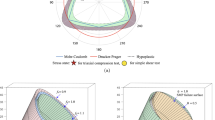Summary
¶Strain-dependent hydraulic conductivities are uniquely defined by an environmental factor, representing applied normal and shear strains, combined with intrinsic material parameters representing mass and component deformation moduli, initial conductivities, and mass structure. The components representing mass moduli and structure are defined in terms of RQD (rock quality designation) and RMR (rock mass rating) to represent the response of a whole spectrum of rock masses, varying from highly fractured (crushed) rock to intact rock. These two empirical parameters determine the hydraulic response of a fractured medium to the induced-deformations. The constitutive relations are verified against available published data and applied to study one-dimensional, strain-dependent fluid flow. Analytical results indicate that both normal and shear strains exert a significant influence on the processes of fluid flow and that the magnitude of this influence is regulated by the values of RQD and RMR.
Similar content being viewed by others
Author information
Authors and Affiliations
Rights and permissions
About this article
Cite this article
Liu, J., Elsworth, D., Brady, B. et al. Strain-dependent Fluid Flow Defined Through Rock Mass Classification Schemes. Rock Mech Rock Engng 33, 75–92 (2000). https://doi.org/10.1007/s006030050036
Issue Date:
DOI: https://doi.org/10.1007/s006030050036




